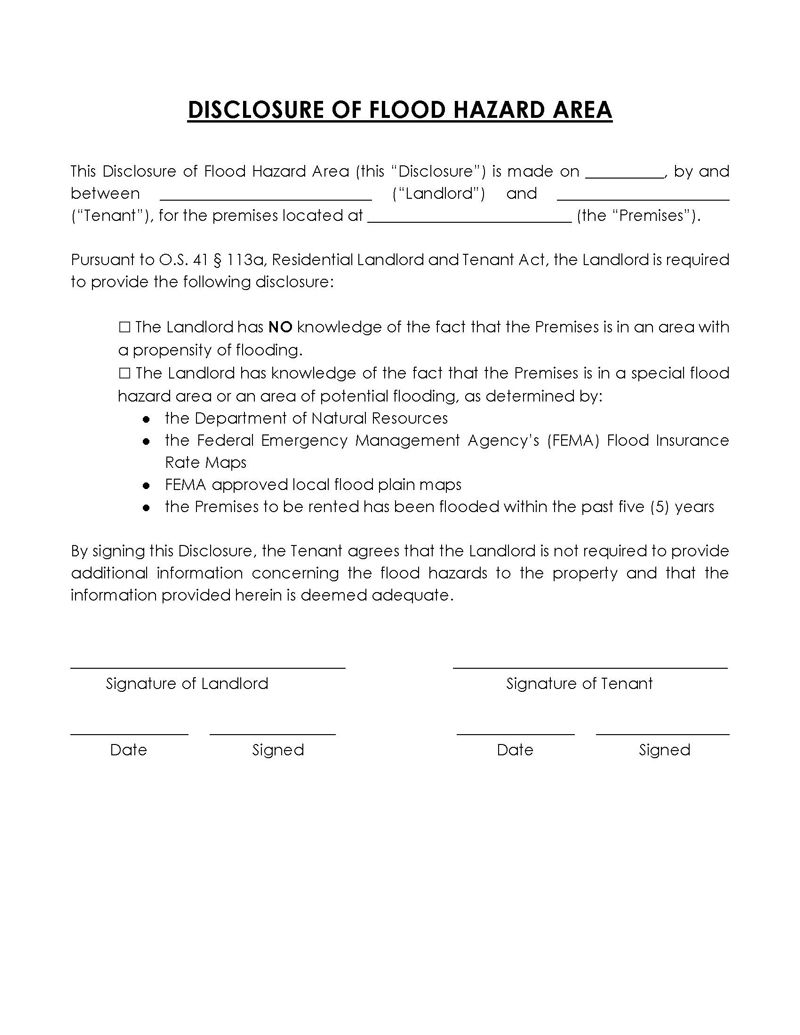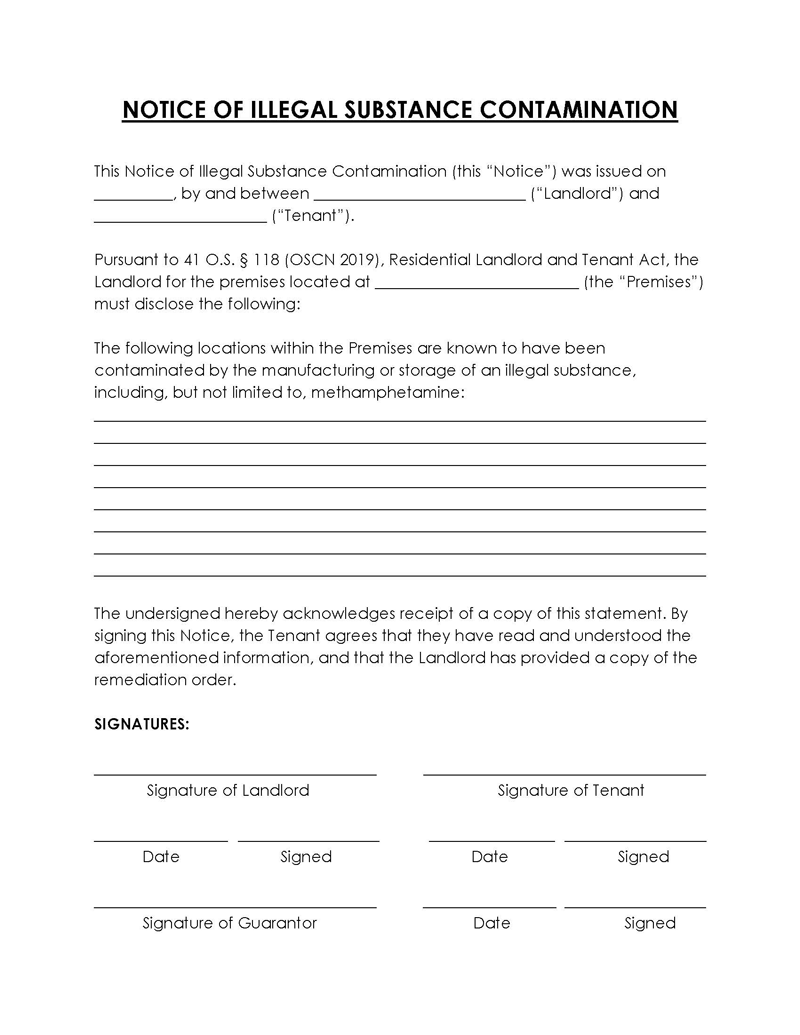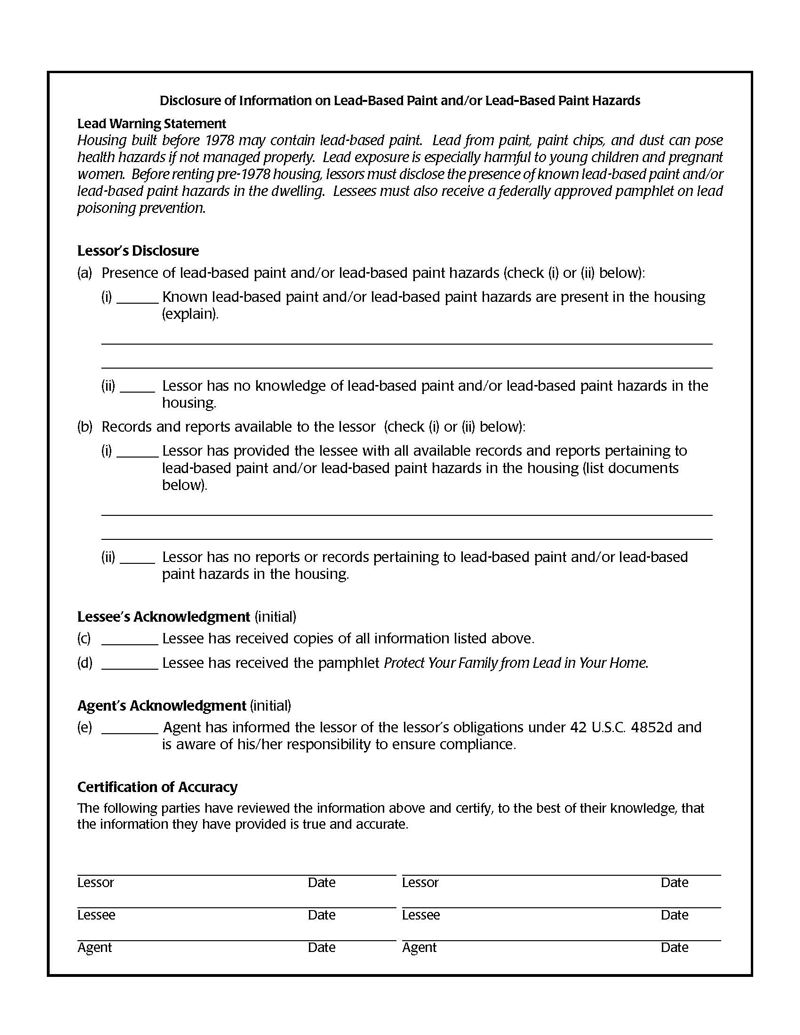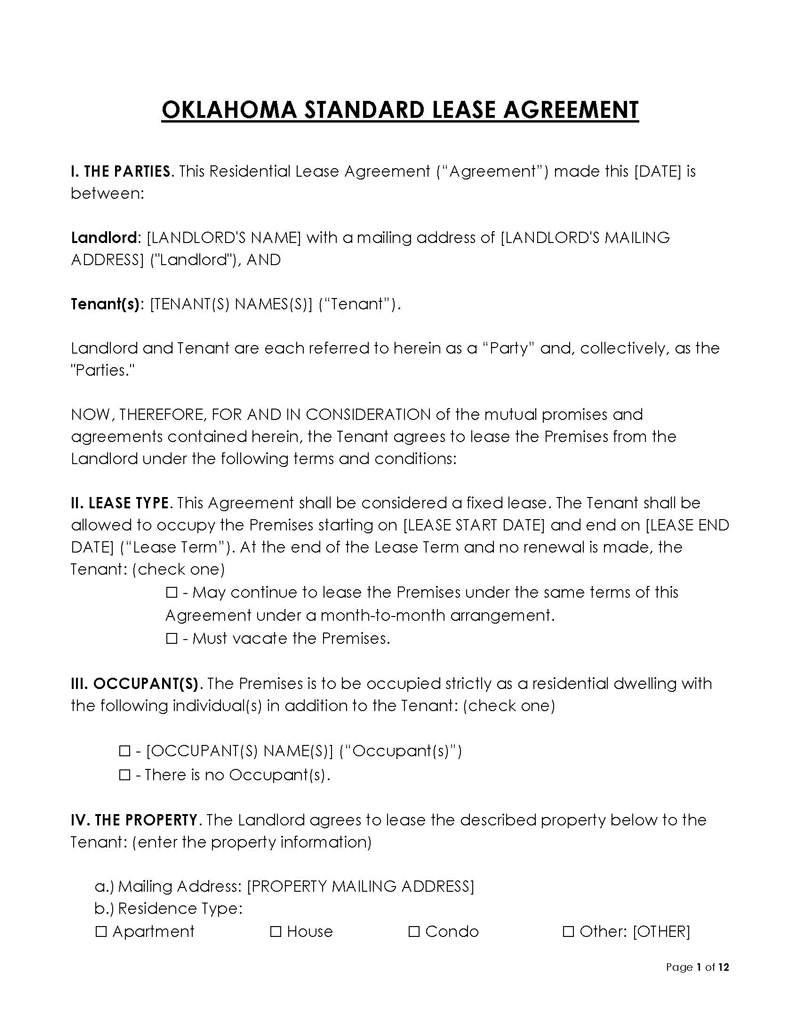The United States federal laws compel anyone renting or leasing a property to enter into a lease and rental agreement. Usually, the agreement is between the property owner or their agent (lessor) and the tenant (lessee), and it is usually signed before the start of the lease term.
According to federal stipulations, all lease agreements should include specific information like the landlord and tenant’s identity, a legal description of the property to be leased, details regarding the safety and health of the property inhabitants, a security deposit, pet guidelines, the rent amount, payment methods, and due dates.
However, despite the general expectations, states still defer lease agreements. As a result, you’ll find certain leasing and rental requirements in line with each state’s rental laws and statutes. As a landlord or a tenant, you must get familiar with Oklahoma’s rental and leasing laws to avoid legal issues or other severe consequences that can affect your chances of renting a property.
Oklahoma Lease Agreement: What is it?
An Oklahoma lease agreement is a written contract between landlords and tenants for residential and commercial properties. To make it valid in Oklahoma, the two stakeholders must include different legal guidelines in it.
When creating a residential lease agreement in Oklahoma, it is best to use the Oklahoma Real Estate Commission (OREC) sample. Similarly, a landlord is expected to verify a prospective tenant’s credit, identity, and source of employment through a rental application before the landlord or their agent prepares an agreement. By doing so, you’ll be able to filter applications and lease your property to the most credible applicant.
In Oklahoma, landlords and tenants can refer to the state’s Renter’s Guidebook for more information about rental rights and privileges. The guide will help both parties comply with the Oklahoma state statutes and understand every detail. Once the two parties have signed and dated the agreement, it becomes legally binding.
Types of Lease Agreements in Oklahoma
There are different types of lease agreements in Oklahoma that a landlord can prepare, as discussed below:
Commercial lease agreement
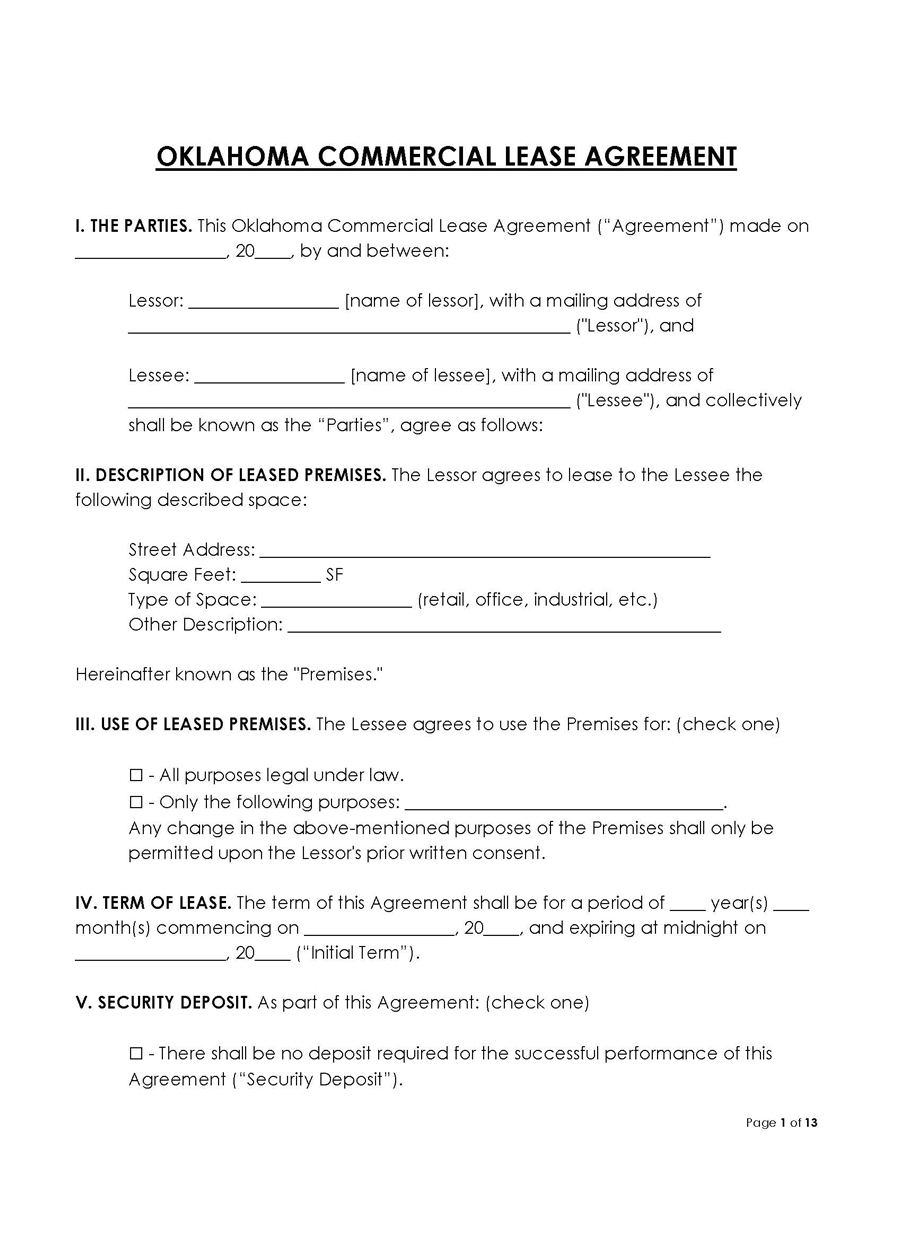
In Oklahoma, a commercial lease agreement is a legal contract between a property owner and a tenant to rent a space not intended for livable use. For example, if a tenant wants to rent an office space or a storage warehouse for their business, they need to sign one with their landlord.
note
A commercial lease agreement can be complicated, so it will be best to read carefully and understand all the details, including each party’s rights and responsibilities, before signing. You may also run the agreement by an attorney before signing.
Month-to-month lease agreement
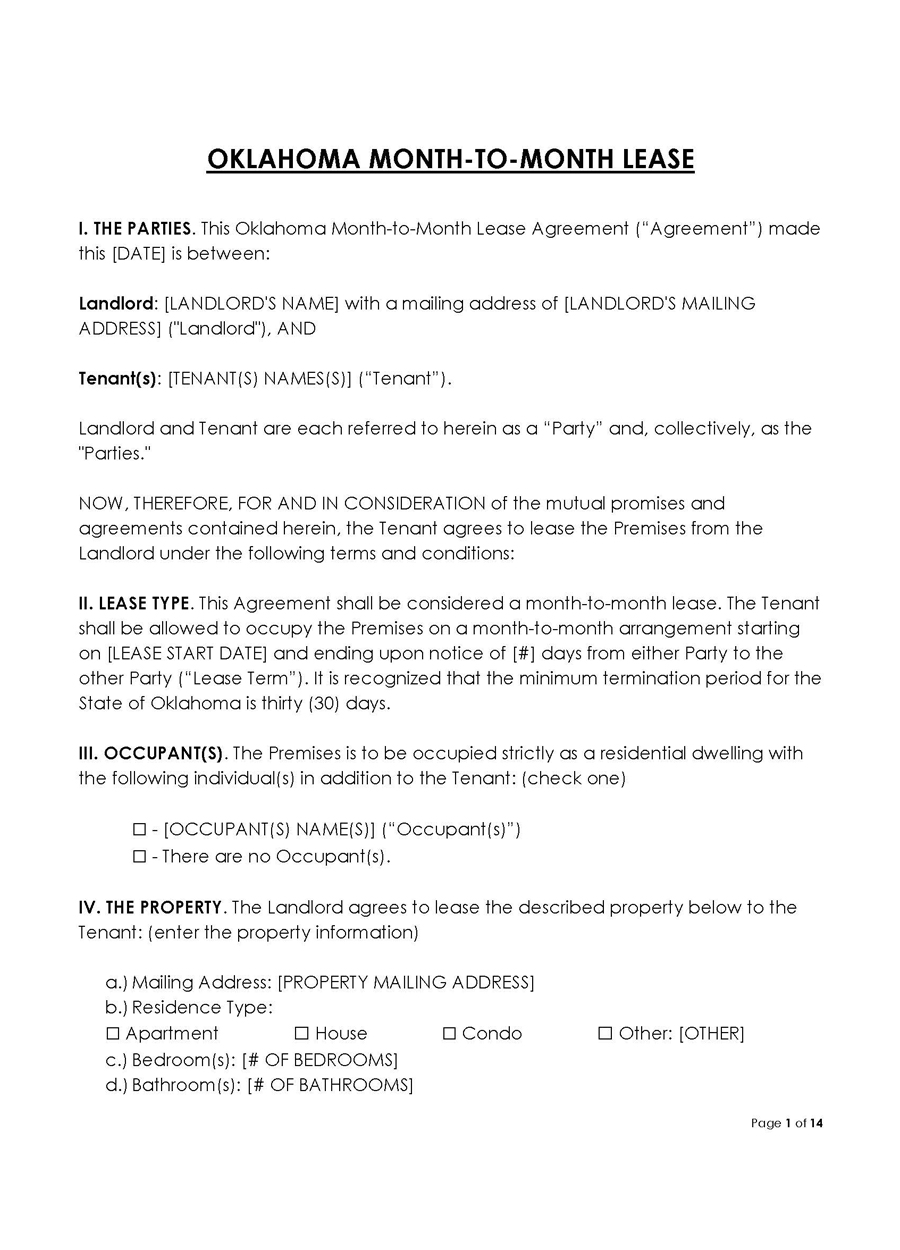
A month-to-month lease agreement (also known as a tenancy at will) is a written, legally binding document between a landlord and tenant for a lease with an undefined end date. With this, the landlord can assume that a tenant will continually occupy a property if the tenant doesn’t state otherwise. However, suppose either party wishes to end the contract or amend the existing terms. In that case, they are expected to issue a 30-day notice and send a lease termination letter to the address and a certified email stated in the lease with a return receipt. Without notice, lease termination or modification cannot happen.
Real estate commission (OREC) lease agreement
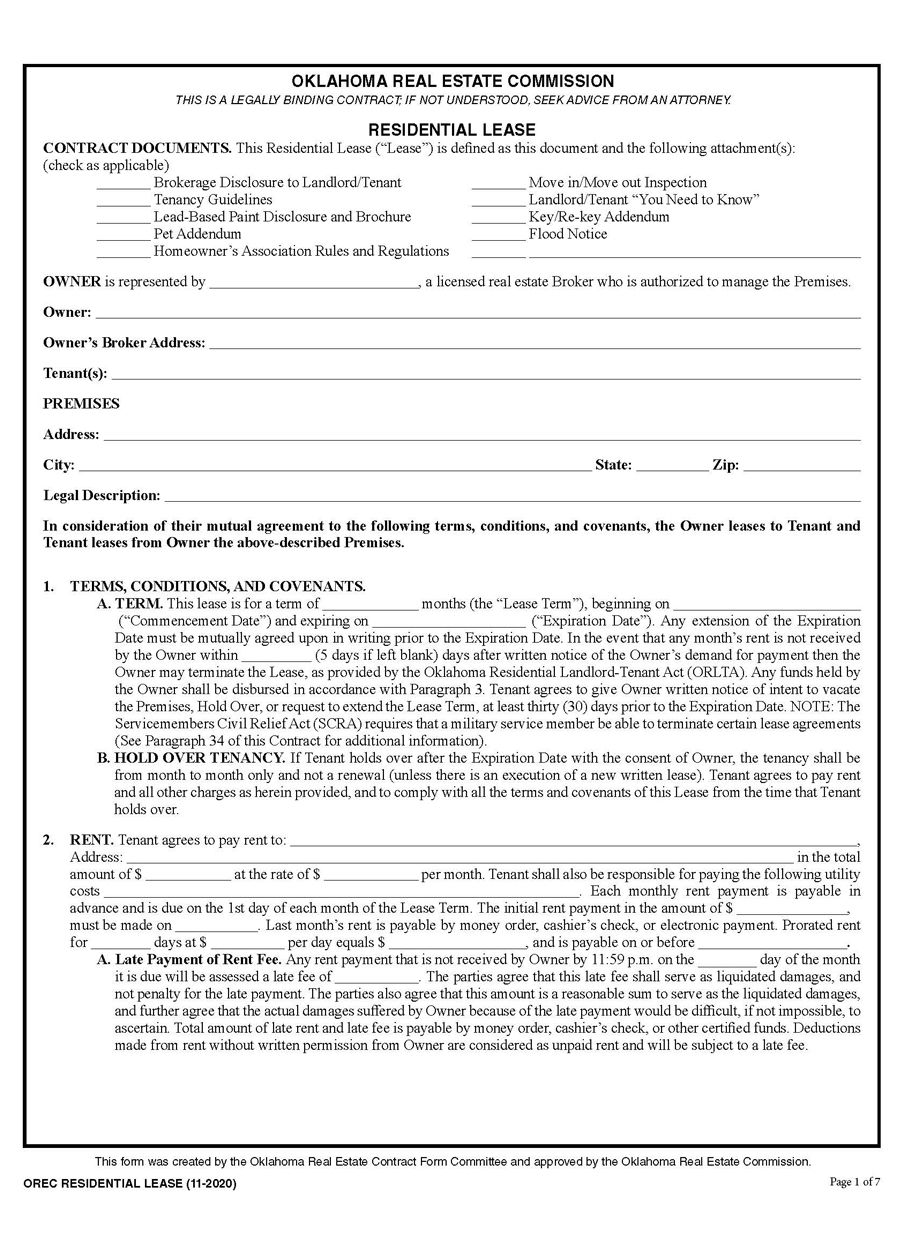
The real estate commission lease agreement is recommended for residential leasing arrangements between property lessors and lessees in Oklahoma. The agreement is included in a lease contract after a potential tenant has sent a rental application and checked the associated rental property. The agreement includes the essential information required by state laws, such as the landlord/property manager’s legal name and flood disclosure.
Rent-to-own lease agreement
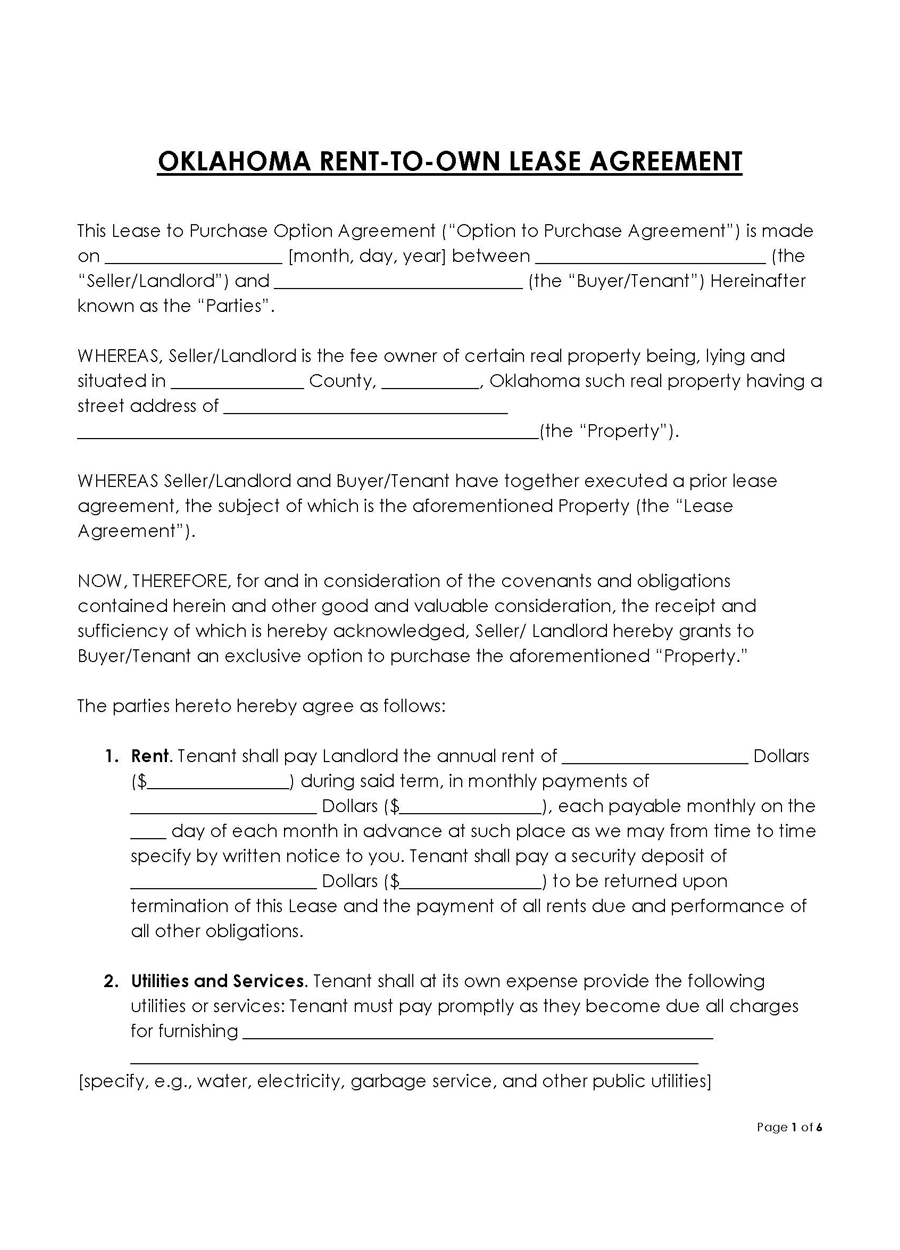
A rent-to-own lease agreement in Oklahoma gives a tenant the option of buying their leased property after meeting certain conditions over an agreed period. Usually, both parties negotiate the purchase terms and agree before the lease is prepared. But in a case where the tenant doesn’t want to purchase the house after their lease expires, the lease will end after the agreed tenure.
Roommate lease agreement
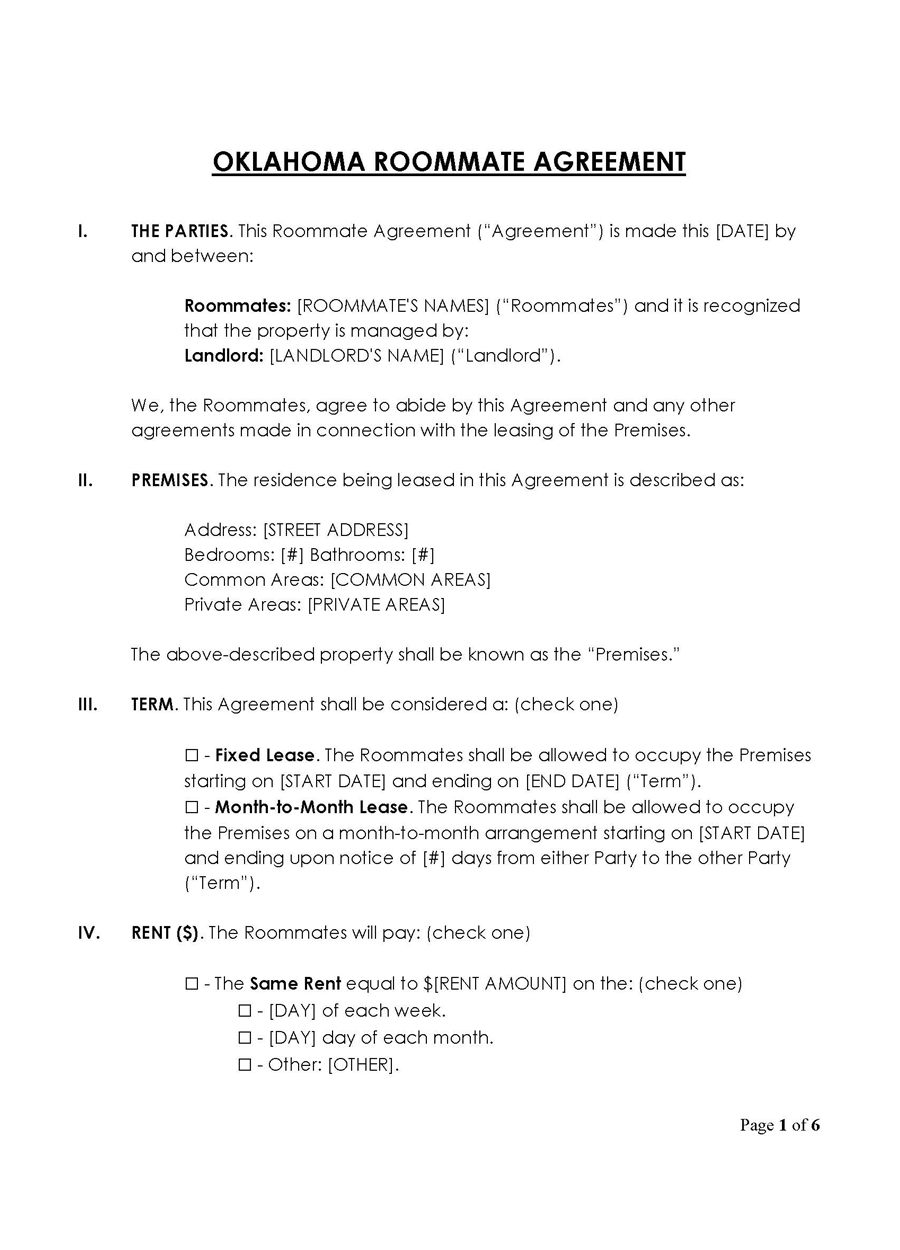
A roommate lease agreement is signed by tenants of a shared apartment and their landlord. In this kind of agreement, both housemates reach an agreement on the pertinent issues in the house, including their duties and responsibilities. By doing so, rent payments can be well structured and settled on time, and the property and its surroundings can be well taken care of.
Standard lease agreement
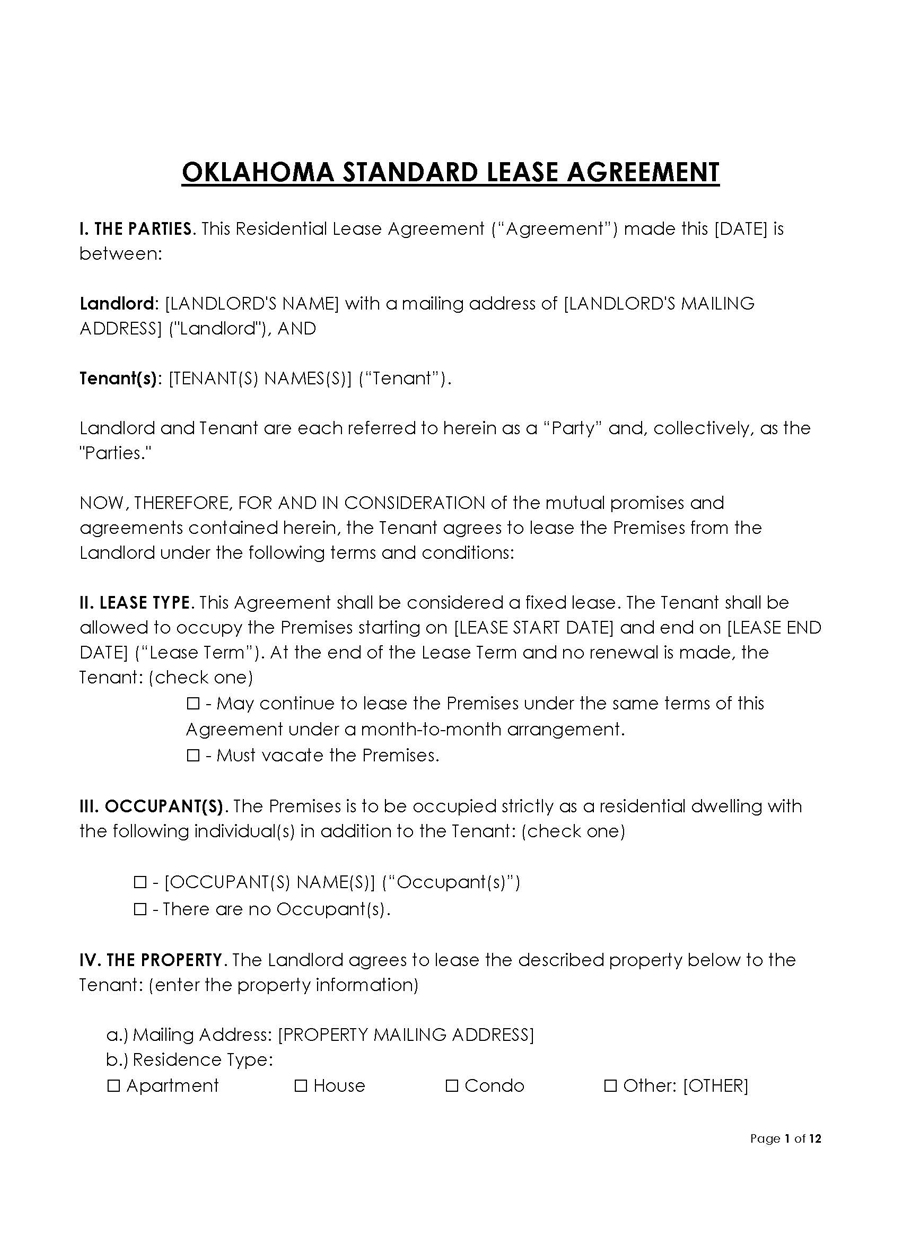
A standard lease agreement that allows a tenant to live in a property for an agreed period (usually 12 months). Apart from the rent tenure, this agreement also highlights the responsibilities of both tenants and landlords, the binding rules and regulations, maintenance costs, rental amount, security deposit, etc. This lease should only be completed after the landlord has verified the potential tenant through a rental application.
Sublease agreement

With a sublease agreement, a tenant of a particular property can re-rent the property to someone else with the consent of the landlord or property agent. In this case, the primary tenant becomes a sub-lessor, the new tenant is a sub-lessee, and the sub-lessee can either live on the property alone or with the sub-lessor. The primary tenant also acts as the landlord, collecting rent from the sub-lessee and paying the property owner. However, if there are any issues with delayed payments, damages, or severe legal issues, the sub-lessor will be liable. So, a tenant should only agree with someone they trust to be their co-tenant.
Compulsory Disclosures Required in an Oklahoma Lease Agreement
Every landlord in Oklahoma is mandated by law to disclose certain information to prospective tenants.
They include:
Landlord or agent’s name and address
In Oklahoma, the law states that anyone managing a rental property (either a landlord or property agent acting on the landlord’s behalf) must disclose their names and addresses to the tenant in a lease agreement before the lease commences. This is usually done for future demands and notices about the property to be correctly delivered to the manager.
Flooding
If a rental property has experienced flooding five years before the lease commences and may still be prone to future flooding, a landlord must include the information. The tenant is believed to have accepted the risk once they signed the document.
Methamphetamine contamination
Suppose a building or a part of it has been used to manufacture methamphetamine in the past. In that case, the property owner is obligated by law to disclose such information in a lease agreement if they’re aware. However, no disclosure is needed if the landlord is sure the contamination level is below 0.1 mcg per 100 square centimeters of the affected building surfaces.
Lead-based paint
The federal laws mandate the owner of a rental property built in Oklahoma before 1978 to disclose in the lease agreement to a potential tenant that the building is painted with lead-based paint. In addition, the landlord is expected to attach a lead-based paint disclosure form and provide tenants with an EPA-approved pamphlet to help them understand the risks associated with living in lead-based painted houses.
Bed bug disclosure
If bed bugs have ever infested their rental property, a landlord must add this supplement to a lease agreement. The landlord is also expected to provide potential tenants with the necessary information they need to know about managing the situation. With this knowledge, the tenant will be prepared for what is to come and work closely with the landlord to manage the situation if it occurs during their lease term.
Asbestos disclosure
For properties built before 1981, asbestos was a common building material. Therefore, if a rental unit was built with asbestos, the law requires the property owner to inform their prospective tenant about it. This will help the tenant steer clear of activities like sanding, pounding, or other repairs that can damage the asbestos when fixing things around the house.
Mold disclosure
Having mold in the house is dangerous, so a landlord must ensure every tenant is aware of the mold status of their rental property before a lease commences. By doing so, the tenant will only move in if they consent to live in such a property, and the landlord will avoid future liabilities if there is a case of mold damage due to the tenant’s negligence.
Shared utility arrangements
For shared apartments, landlords should inform all the tenants about which utilities they can use together, how they can share the utilities, the associated bills, and how the bills will be paid. By doing so, each tenant will be able to calculate their additional bills based on the utilities they decide to use and add to their rent.
Late and returned check fees
In Oklahoma, the law allows landlords to charge their tenants late and returned check fees. However, the landlord must inform the tenant about the amount of the fee and when it’s to be paid. There is no limit to how much a landlord can charge a penalty for late and bounced check fees, but they are often 10% of the rent amount.
Move-in checklist
A move-in checklist highlights all the damages to a property before a tenant moves in to begin a lease tenure. It also highlights what the landlord considers damage to the property outside of the highlighted issues. Once a tenant signs a lease agreement with a move-in checklist, they are liable for any severe damage to the property during their lease term.
Medical marijuana use
In Oklahoma, state laws allow landlords to limit marijuana usage to only non-smoking methods. Still, landlords are expected to disclose information about marijuana use. However, suppose a landlord allows marijuana use (smoking or non-smoking) on their property. In that case, they should also include information like where concerned tenants can smoke on the property to protect the non-smoking inhabitants.
Important Information to Include in an Oklahoma Lease Agreement
Apart from disclosures, crucial information must be included in a lease agreement in Oklahoma. This information is per the law and is non-negotiable.
Landlord and tenant’s names
The landlord’s (or property agent’s) and the tenant’s legal name(s) must be mentioned.
Property’s full address
This section includes the full address of the property. In addition, important information like the city, its location, zip code, and property number should also be included.
Lease term
The term section should clearly state information about the type of agreement both parties are entering and the length of the lease period.
Rent
In this section, the landlord should include the lease’s start date, monthly rent amount, the rent due date, and where the payment should go.
Late fee and penalty
This is the amount the tenant must pay when they fail to pay their rent when it is due.
Security deposit
This is the deposit a tenant must pay before moving into the property. It is usually kept by the landlord to fix damages caused by the tenant. You should clearly state the amount and the conditions for a refund if there are no extreme damages by the tenant.
First payment
This covers the total of the first amount a tenant must pay before moving into a property. Usually, it is the addition of the first month’s rent and the security deposit.
Information about other occupants
In residential properties, the landlord is expected to list the legal names of all the tenants in their building. In addition, tenants with partners and children should also provide those names.
But, for commercial properties, the landlord should list the names of the primary tenant and the names of everyone else who goes to or works in the building should be added to the list. If the tenants have to pay additional costs for having more people use the property, the landlord must clearly state this
Utility details
The landlord should highlight the utilities and services a tenant isn’t responsible for in this section.
Parking system
Information like whether a tenant has access to a parking space or not should be added to this section of the agreement.
Property furnishing
In this section, the landlord should list all the equipment and appliances a tenant can and cannot install in the apartment. And if the property is already furnished, it should be disclosed here.
Details for notice
In this section, the landlord’s (or property manager’s) and tenant’s names and mailing addresses should be documented to contact each other or send notices.
Eviction information
This section helps the tenant understand the possible grounds for eviction and how it will be carried out, especially regarding rent payments or any other contract breach.
Additional information
At this point, the landlord adds any other information they believe the tenant should know that hasn’t been mentioned in any of the other sections.
Signature and date
Finally, both the lessor and lessee should sign and date the agreement to make it legally binding.
Landlord and Tenant Laws in Oklahoma
Before entering a lease agreement, there are additional landlord-tenant laws and statutes that every property owner and tenant should be familiar with:
Security deposit
No statute in Oklahoma limits how much a landlord can charge a tenant as a security deposit. However, a landlord must store whatever amount a tenant pays as a security deposit in a state-owned escrow account and must return it to the tenant within 30 days of their lease termination on the condition that the tenant requests to have their deposit refunded within six months of termination.
Right of entry
Before a landlord can access a leased property in Oklahoma, they must notify the tenant 24 hours prior, even for maintenance reasons. However, if there’s an emergency, the landlord can access the property without notifying the tenant beforehand.
Domestic violence
There are no laws or statutes concerning domestic violence in Oklahoma. However, the Oklahoma Coalition Against Domestic Violence and Sexual Assault has a list of domestic violence support organizations in the state.
Oklahoma Lease Agreement Template
Final Thoughts
A lease agreement is a landlord-tenant legal contract that the Oklahoma rental laws make compulsory for landlords and tenants. Both parties have obligations they must comply with before entering an agreement. In this article, you’ve learned the essential details to look out for in a lease agreement and how to protect yourself whether you’re an Oklahoma landlord or a tenant starting a lease.
